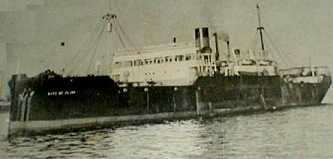After nearly a month under German control, the American freighter City of Flint was set free following a pre-dawn raid Nov. 4, 1939, while the ship lay at anchor in the port of Haugesund, Norway. Norwegian navy sailors boarded and arrested the German prize crew for violating Norway’s neutrality laws. (See blog post City of Flint Odyssey, Part 7, Dec. 15, 2015.)
Flint’s captain, Joseph Gainard, and her crew were once again in charge of their own ship, and their first stop was Bergen, Norway, where Gainard was met by the U.S. consul and learned for the first time of the U.S. State Department’s non-stop effort over the previous three weeks to free the ship. Also waiting for City of Flint in Bergen was a small army of newspaper reporters and newsreel photographers, all wanting to interview Gainard.
“I have no story to tell,” Gainard told the media, as he related in his memoirs. “I’m not a salesman. I’m a sailor.” He explained his first priority was to prepare reports for the U.S. State Department concerning the ship’s seizure and their experiences in Murmansk, Russia. The captain and crew also met with the American Minister to Norway, Mrs. Florence Jaffray Harriman. Only after the official reports were filed did Gainard finally meet with reporters.
In the month that City of Flint had been sailing to Norway, Russia, and back to Norway, U.S. neutrality laws were revised to prohibit American flag ships from entering war zones. With the original ports in Great Britain no longer a possible destination, Gainard needed to arrange to offload the ship’s cargo elsewhere.
They sailed the last week of November, returning to Haugesund, where it took three weeks to find buyers and discharge the cargo. City of Flint sailed back to Bergen for fuel, and headed out to sea again on Dec. 22, bound for the port of Narvik on Norway’s northern coast. There they loaded a cargo of iron ore, but foul weather kept them in port for more than two weeks.
“Christmas morning I was shaving,” Gainard later wrote. “Looking at myself in the mirror I saw my face and said, ‘Well, here’s a Merry Christmas to you—from me, anyway.’”
Finally on Jan. 7, 1940, City of Flint left Narvik bound for the U.S. It took the freighter three weeks with its heavy cargo to cross the stormy North Atlantic and arrive in Baltimore, finally ending her strange odyssey.
Sadly, neither City of Flint nor her captain survived the war.
Gainard, who was an inactive U.S. Navy reserve officer, received the Navy Cross for his steady hand throughout the seizure of his ship. He returned to active duty in 1941 and commanded an armed merchant ship and later the attack transport USS Bolivar. He died of natural causes on Dec. 23, 1943, at age 54.
But Gainard had survived his old ship, City of Flint, by almost a year. The doughty little freighter sank in the Atlantic on Jan. 27, 1943, when her convoy was attacked by German U-boats.



